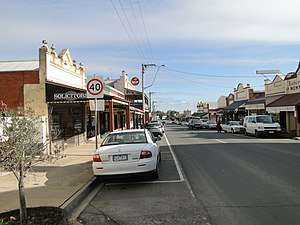Rutherglen (Victoria)
For the town in Scotland, see Rutherglen (Scotland).
Rutherglen is in the state of Victoria located not far from the border of New South Wales. Closest major city is Albury/Wodonga
Understand

Rutherglen, Victoria is one of Australia's oldest wine growing regions situated in North-East Victoria, located near the banks of the Murray River. It is world renowned for its wine making, with many wine makers passing their skills and expertise down through generation after generation.Rutherglen is known for its Durif, Muscats, Ports and Tokays.
History; Founding the Local Area: Back in 1824 an exploration party led by Hamilton Hume and William Hovell traversed the local area on the approximate route of the present Hume Highway. First settled in 1836 by James Lindsay Brown and Thomas Clarke at Gooramadda, John Foord and John Crisp at Wahgunyah and Joseph Bould at Boorhaman.
Discovery of Gold: In 1858 Gold was found in the local area at Chiltern and Cornishtown, which started a wave of prospectors sinking duffer shafts along the quartz belts. A group of diggers spent several weeks digging a hole in the heart of Rutherglen (next to where Tuilleries now stands). On Saturday September 9th, 1860 they finally struck gold starting the 'Wahgunyah Rush'. Within weeks thousands of people had moved to Rutherglen. By December of that year seventeen deep leads and seven reefs of gold had been found.
The Main Street of Rutherglen was established and staked claims were selling for 10 pounds per foot. The Star Hotel was the first major establishment in the town on the corner of Argyle (Main) and Elizabeth (High) streets. Here the name of 'Rutherglen' was established over a few drinks! David G. Hamilton suggested if the proprietor of the 'Star', John A. Wallace was prepared to shout the bar he could call the town after his native town in Scotland. Wallace replied, "Right you are Davie, Rutherglen it shall be".
To provide for the rush, Calico and Hessian business houses sprang up. Twenty-one licensed hotels were founded with dancing saloons and places of entertainment. The men outnumbered the woman twenty to one. Cartloads of women were encouraged to move up from Melbourne. The women were hired to dance in the evenings. Many of these women married and settled in the area. From the original twenty-one hotels, three now remain, The Star, The Victoria, and Poaches Paradise.
Rutherglen quickly established into a commercial centre. By January 1861 Rutherglen had its own newspaper, three schools, a police station, and a large selection of shops lining the main street from end to end. The Rutherglen area had suddenly grown to a population of 20,000 people within months.
By the 1880s the rush had slowed a great deal, many people moved away from the area and more and more mines closed. One mine now called, 'The Great Northern' closed in 1886. Jack McKay and John Hicks purchased the site believing that they would find gold. The previous owners had abandoned the mine at 216 feet with no success. Jack and his party cleaned the old shaft and only had to dig 6 feet before finding Gold. They found a lead of fifty foot wide by three foot thick. This mine was then sold to a Ballarat company for 14,000 pounds. This became one of Victoria's largest Gold mines producing over 107,000 ounces of gold with profits exceeding 190,500 pounds. This started a second rush that lasted until World War I.
Winemaking: The Rutherglen Wine District is one of Australia's oldest wine regions. Lindsay Brown planted the first vines in the 1850s. Others soon followed with the success of exporting Burgundies to England. The Victorian Government could see the potential and offered a bonus of £2 for every acre of vines planted in the area. This helped increase the area planted with vines from 700 acres in 1881 to 3500 in 1885. By 1890 Rutherglen was producing a quarter of Australia's wine. In the late 1890s Phylloxera, a vine aphid, which attacks the roots of the plant, spread through out North East Victoria with most vines having to be uprooted and burnt. Some vineyards had to close, with the remains still standing today. The local Viticultural College geared up to help with this problem and supplied over five million new rootlings from American phylloxera-resistant stock.
Get in
The nearest major airport to Rutherglen is at Albury. If driving from either Melbourne or Sydney, the Hume Highway gives the quickest access, turning on to the Murray Valley Highway between Wangaratta and Albury.
Get around
See
- 🌍 The Big Wine Bottle. (at the junction of Hunter and Campbell Streets). The big wine bottle is clearly visible approaching the town from many directions. The bottle is based upon the town's old water reservoir being added to in more recent times to represent the strong connection Rutherglen has with the wine industry.
- 🌍 Rutherglen Wine Experience and Visitor Information Centre, 57 Main St.
Do
Buy
Eat
Drink
Sleep
Rutherglen has an excellent choice of motels, hotels, self contained accommodation, guest houses, traditional B&Bs and pet friendly accommodation.